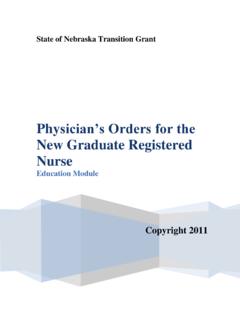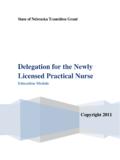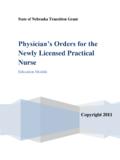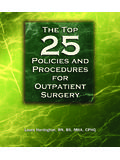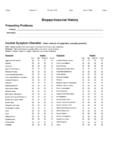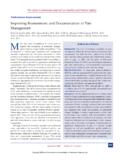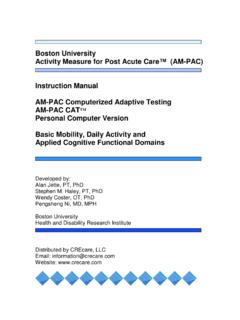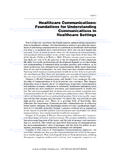Transcription of Critical Thinking/Clinical Reasoning for the Newly ...
1 State of Nebraska Transition Grant Critical Thinking/Clinical Reasoning for the Newly Licensed Practical Nurse Education Module Copyright 2011. Title: clinical Reasoning / Critical thinking Learning Objectives: Upon completion of this communication module, the Newly licensed practical nurse will: Discuss the importance of prioritization of patient care. Apply principles of time management in patient care. Draw conclusions from patient data. Differentiate priority and non-priority patient needs. Prepare organizational tools that will be utilized on a regular basis. Interactive Exercises: 1. View the following content with your preceptor. 2. Brainstorm with your preceptor, possible situations that could occur during a shift and how to anticipate patient needs.
2 3. Prioritize patient needs from highest to lowest. 4. Distinguish which patient data would need to be reported to a physician, licensed provider and/or registered nurse. 5. Develop a tool to help you organize your day (or utilize one already prepared by your facility). 6. Discuss with your preceptor, the scheduled activities during a typical shift (meal times, etc.). 7. While listening to report, create a plan for your day and at the end of each day evaluate your plan with your preceptor. 2. Transition to Practice: Critical thinking clinical Reasoning Prioritizing nursing care may be based on Maslow's Hierarchy of Needs. We must meet the physiological needs such as oxygenation, before we can move up the pyramid and meet the other needs of the patient.
3 Prioritization of Nursing Care nurses need to recognize what are immediate needs and what issues can wait. It does not mean they are not important, but they are not the highest priority. A = airway has the highest priority. We cannot live without oxygen, which enters our airway. B = breathing is the next highest priority. Oxygen enter the body by breathing. C = circulation is the third highest priority. Oxygen must be moved to the tissues where it is needed, in order for the cells to survive. Prioritization practice begins with assessment . The assessment must be performed quickly and nurses must respond quickly with appropriate interventions. Prioritization Practice # 1.
4 A patient is brought into an outpatient department with chest pain and dyspnea. What is the highest priority action for the nurse? Obtain vital signs and check the percentage of oxygen saturation Obtain a complete history 3. Draw blood for lab tests Start an intravenous infusion Prioritization Practice # 2. On your next assessment of this patient you note the temperature is F ( C), respiratory rate is 32/minute, apical pulse is 116/minute and SaO2 is 89% on room air. Assuming all of the following interventions were ordered, place the following interventions in order of priority: Obtain a sputum culture Administer an antibiotic Administer an antipyretic Administer oxygen therapy Prioritization Practice # 3.
5 Which of the following assessment data, collected on a patient with chronic obstructive pulmonary disease (COPD) would be the most important to report to the physician? SaO2 90% on room air Apical pulse of 98/minute Blood pressure of 146/86. Clubbing of fingers and circumoral cyanosis Prioritization Practice # 4. Your patient is receiving a blood transfusion and complains of itching and hives are noted. Place the following interventions in the priority order. Maintain the IV infusion with normal saline Assess vital signs and airway patency Stop the blood transfusion Notify the primary care provider Prioritization Practice # 5. You are assigned a patient with type 1 diabetes mellitus who has an order for blood glucose monitoring before meals.
6 In what order would you perform the following interventions? Complete a head to toe assessment Check vital signs Teach patient about diabetes Obtain finger stick for blood glucose level Administer insulin injection Assist patient with breakfast Time management and organizational skills are important for the nurse. Time may be wasted by some of the following activities. Try to think of other time wasters. Keep an activity log for one of your shifts, to determine how you spend your time and review it with your preceptor. Identify time wasters and how to eliminate them. Telephone calls Lack of prioritization and organization Lack of planning Lack of knowledge Failure to make appropriate assignments Ineffective communication Unscheduled meetings 4.
7 Time Management Practice Activity: Take out a piece of paper and divide it into two one-hour increments. Indicate patient meal times. Include when medications are scheduled. Are patients scheduled for any tests, therapy, When do most of the physician's make rounds? Time Management Tips: Arrive early for your shift and organize your day. Try to anticipate the unexpected.. Listen carefully during shift report and note Critical information.. Review your assignment and note any patients who might need extra time. Consider tasks which could be assigned to the unlicensed team members.. Make sure you have time management tools readily available pen, scissors, stethoscope, small notebook, watch, etc.
8 Be flexible; expect and plan for interruptions.. Do not leave documentation until the end of the shift. Plan to do it throughout the shift.. At the end of your day, take a few minutes to plan for the next day.. Prioritization Practice # 6. You are assigned the following patients how would you plan your day? Patient A had a colon resection yesterday and is scheduled for a dressing change . Patient B had a hip replacement 2 days ago and is scheduled for physical therapy at 0900 . Patient C is an insulin dependent diabetic who needs his blood sugar tested before breakfast . Patient D was admitted yesterday evening and puts on the call light complaining of chest pain.
9 Prioritization Practice # 7. The nurse is preparing to begin the shift after listening to report. Which of the following patients should the nurse see first? A patient 4 hours post-cardiac catheterization with mild discomfort at the access site . A patient diagnosed with diabetes mellitus who needs reinforcement of sick day management guidelines . A patient who arrived on the unit 30 minutes ago from the post-anesthesia care unit . A patient with pneumonia who has received 2 doses of intravenous antibiotics and has an oxygen saturation of 91% . Check your answers to the prioritization practice questions on the next page. Review your answers with your preceptor.
10 Prioritization Practice # 1. Based on the information given related to the ABCs, the appropriate answer is to obtain vital signs and check the percentage of oxygen saturation. Prioritization Practice # 2. The following would be the correct order: 5. Administer oxygen therapy . Administer an antipyretic . Obtain a sputum culture . Administer an antibiotic . Prioritization Practice # 3. The answer is clubbing of fingers and circumoral cyanosis, which should be reported. Prioritization Practice # 4. The following would be the priority order of interventions: Stop the blood transfusion . Maintain the infusion with normal saline . Assess vital signs and airway.

